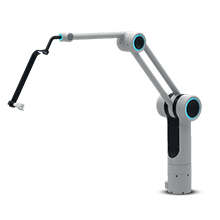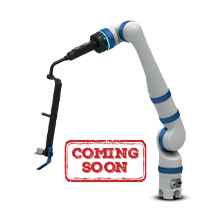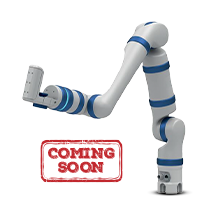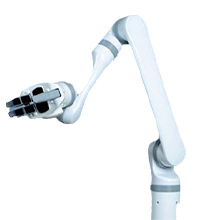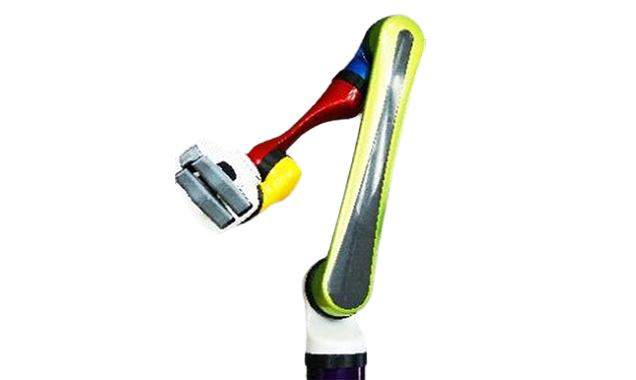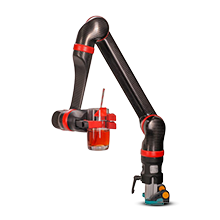
EU Projects
Accrea Medical Robotics carries out its research and development activities with the support of European funds. The following section contains detailed information on co-financed projects, including their strategic objectives, expected results, total financial value and scope of co-financing obtained.
Project implemented under a co-financing agreement with the Polish Agency for Enterprise Development (PARP)

Increasing the competitiveness of ACCREA through the implementation of innovation resulting from a design audit and a developed Design Strategy.
DESIGN AUDIT
ACCREA commissioned a design audit understood as a comprehensive analysis of the company's activities in terms of design potential and needs. The design strategy (hereinafter SW) developed on the basis of the audit contains recommendations regarding further actions related to the use of design in the company in the scope of individual areas of activity, i.e. values, offer, business model, technology, organizational structure and communication processes.
RECOMMENDATIONS FROM THE DESIGN STRATEGY
- •Introduction to production of a new robot with active gravity compensation supporting upper limb mobility of people with hand paresis – NeuroFlex Assist
- •Creating and implementing a marketing strategy for product innovation
- •Creating marketing materials for the new product brand
SCOPE OF PLANNED ACTIVITIES
- •Conducting a design audit and developing the Design Strategy (21.06.2024-12.07.2024)
- •Designing a new product (2.01-31.05.2026)
- •Prototyping of a new product (01.09.2025-31.05.2026)
- •Testing of a new product (1.09.2025-30.06.2026)
- •Purchase of other consulting services necessary for SW implementation (1.09.2025-31.08.2026)
- •Purchase of fixed assets necessary for SW implementation (1.09.2025-31.08.2026)
PLANNED ACTIVITIES USING DESIGN PROCESSES
As a result of implementing the DS recommendations, the final result will be the market introduction of:
1. Product Innovation
An innovative robot for supporting and motorizing upper limb movements, enabling people with mobility disabilities to perform daily activities while supporting rehabilitation and maintaining the user's muscle function.
The product innovation will be developed in accordance with the use of full design processes and will include stages:
- •DESIGN - will include the creation of a detailed design project that will focus on the development of technical, functional and aesthetic features of the product.
- •PROTOTYPING - the first physical model of the robotic arm will be created, which will be tested for compliance with the assumptions of the design project. Prototyping will enable the introduction of necessary corrections and improvements before the final implementation of the product on the market.
- •TESTING - will include the evaluation of the functionality, durability and aesthetics of the prototype. Testing aims to ensure that the final product meets all the assumed technical, functional and aesthetic standards and is ready for market introduction.
2. Innovation in Business Processes:
In the organizational process:
• NEW ORGANIZATIONAL STRUCTURE (designation of a design coordinator)
In the scope of Marketing Innovation:
- • NEW SUPPORTING FUNCTION - PRODUCT: Refabrication
- • NEW MARKETING METHODS: Marketing Strategy, Digital sales support, Design Management System, Brand Management System, New product presentation method
EXPECTED PROJECT RESULT
The final result of the project will be the implementation (no later than the last day of the project) on the market of an innovative robot that will significantly improve the mobility of patients' upper limbs, enabling them to perform daily activities with greater precision and less effort.
The implementation of the project will increase the company's competitiveness through:
- •Introduction to the market of the innovative NeuroFlex Assist
- •Increasing the share of recyclable materials in the product composition to 25% of the entire product
- •Ensuring accessibility for groups: people with neurological diseases or their complications, elderly or weakened people who need support in performing daily activities
The project will contribute to strengthening the company's position in the market, increasing customer satisfaction and implementing a sustainable development strategy. The activities planned in the project result from recommendations and are consistent with the company's development vision, and the scope of recommendations was justified in detail in the DS. These activities will contribute to comprehensive optimization of the production, organizational and marketing process, which will affect the increase in competitiveness.
PRODUCT PURPOSE
NeuroFlex Assist is intended for patients with neurological deficits affecting the upper limb, manifested by weakening of muscle strength and reduced mobility. The device is an ideal solution for patients with diseases such as stroke, multiple sclerosis (MS), amyotrophic lateral sclerosis (ALS), mechanical damage to the hand and spine, demyelinating and inflammatory diseases of the CNS. Thanks to passive and active modes, NeuroFlex Assist is useful for patients at various stages of disease development. The product will support rehabilitation and daily functioning, enabling users to perform activities such as reading, writing or eating.
Total project cost: 4 986 822,00 PLN
European Funds contribution: 2 973 735,00 PLN
#FunduszeEuropejskie #FunduszeUE
Project implemented under a co-financing agreement with the Lublin Agency for Enterprise Support (LAWP)
Hybrid robotic arm for assisting in minimally invasive surgery AVROS

Project Description:
There is a growing demand for specialized medical care, with deepening staff shortages. Minimally invasive surgery (MIS) is typically performed by a surgeon with 1-2 assistants operating the camera, holding instruments, patient organs, etc. Their remuneration increases the overall cost of the procedure, and the need to manage them (verbal communication, supervision) is burdensome for the surgeon.
The innovative, hybrid robotic arm AVROS, representing significant scientific and technological progress, aims to:
- •Reduce operation costs by relieving assistants; ultimately enabling work without assistants
- •Increase surgeon comfort through advanced, proactive and intuitive control methods
- •Improve the quality of medical services, shorter procedure time, shorter waiting time for the procedure
System Description:
AVROS consists of a set of robotic arms and modules for perception and surgeon support. These arms can function as both a visual pathway arm and an arm supporting MIS tools. They can be configured in a system of 1, 2 or 3 arms, mounted on a table or an independent base. The structure of the arms, dimensions, kinematics and positioning will allow them to be used in most (90%) types of MIS operations. The system is compatible with most commercially available endoscopes, MIS tools and operating tables. The arms are lightweight (<10kg) and the intelligent control system ensures safe and intuitive operation by the surgeon and support staff.
Project Stages:
The project is divided into 4 stages:
Stage 1
Includes industrial research on robotic technologies applicable to the arm from the mechanical side, i.e. drive modules with haptic features, kinematic chain connecting the redundant motorized part and the adjustable passive part with reading of the exact position of each axis of the passive part in space, laparoscopic camera mounting mechanism with ensuring rotation of laparoscopic optics, and laparoscopic tool mounting mechanism with quick-mount connector for changing tools or camera during operation. Industrial research on algorithms for controlling arm components and the entire arm, i.e. algorithms for controlling haptic drives, controlling redundant kinematics, shared control.
Stage 2
As part of experimental development work, each subsystem will be integrated and subjected to comprehensive engineering tests of hardware/software (including EMC) and functionality (surgeons). The stage includes the construction of 2 sets of the system, each consisting of 2 arms.
Stage 3
Includes preparation for the implementation of the AVROS product on the market, primarily to neighboring countries belonging to the European Union due to common regulations regarding the registration of medical devices.
Effect of R&D work
The effect of R&D work will be the introduction of an innovative product on the market - Intelligent robotic system AVROS. The system will be innovative in terms of user interfaces, extended possibilities for manipulating the laparoscopic camera, algorithms for semi-autonomous movement based on detected activities. The product will be implemented for production.
Target Groups:
AVROS is dedicated to MIS surgery hospitals, one-day surgery, surgical practices.
In the current state of the art, the procedure is performed by 1 surgeon and 2-3 assistants (assistant surgeon and 1-2 scrub nurses), whose task is to lead and maintain the camera, tools and patient organs. There are no solutions available on the market that enable an MIS procedure to be performed by one surgeon.
In the AVROS solution, the role of assistants will be taken over by 1-3 robotic arms controlled by the surgeon, equipped with semi-autonomous supporting functions, increasing work comfort and reducing cognitive effort.
Recipient Groups:
1. Hospitals with surgical departments:
- •PL (2017): 1,096 hospitals, approx. 1.07mn hospitalizations for surgical indications
- •DE (2017): 3,138 hospitals, approx. 4.41mn hospitalizations for surgical indications
2. One-day surgery practices:
In the EU, an increase in the percentage of procedures performed in them was noted, e.g. inguinal hernia repair increased from 20% in 2000 to 40% in 2016 (OECD health at a glance 2018).
Needs: Reducing staff workload, increasing work ergonomics, freeing up some staff to perform other tasks, shortening the procedure time.
Beneficiaries:
Direct beneficiaries of the project results will be practicing surgeons specializing in minimally invasive surgery, who will be directly involved in the practical implementation of the AVROS system during laparoscopic operations performed in hospitals decided to use the AVROS system.
The final beneficiaries of the project results will be citizens using the health care system. Due to the planned pilot implementation of the system in hospitals in the Lublin province, the first beneficiaries will be citizens of the Lublin region.
Total project cost: 5 388 747,91 PLN
European Funds contribution: 3 984 433,27 PLN
#FunduszeEuropejskie #FunduszeUE
We Care About Your Privacy
ACCREA Medical Robotics uses cookies to improve and customize users experience on our website. By selecting 'Accept', you consent to the use of all cookies that gather and use information about your interactions with our site to provide personalized content and enhance your digital experience. Please read our Privacy Policy for more information.

